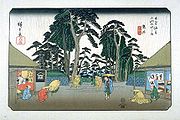
Tarui-juku
Encyclopedia

69 Stations of the Nakasendo
The are the rest areas along the Nakasendō, which ran from Nihonbashi in Edo to Sanjō Ōhashi in Kyoto. The route stretched approximately and was an alternate trade route to the Tōkaidō.-Stations of the Nakasendō:...
of the Nakasendō
Nakasendo
The , also called the , was one of the five routes of the Edo period, and one of the two that connected Edo to Kyoto in Japan. There were 69 stations between Edo and Kyoto, crossing through Musashi, Kōzuke, Shinano, Mino and Ōmi provinces...
. It is located in the present-day town of Tarui
Tarui, Gifu
is a town located in Fuwa District, Gifu, Japan.As of July 2011, the town has an estimated population of 28,461. The total area is 57.14 km².- Railroad :*JR Tōkai**Tōkaidō Main Line - Tarui Station-External links:*...
, Fuwa District
Fuwa District, Gifu
is a district located in Gifu, Japan.As of July 2011, the district has an estimated population of 36,426. The total area is 106.43 km²....
, Gifu Prefecture
Gifu Prefecture
is a prefecture located in the Chūbu region of central Japan. Its capital is the city of Gifu.Located in the center of Japan, it has long played an important part as the crossroads of Japan, connecting the east to the west through such routes as the Nakasendō...
, Japan
Japan
Japan is an island nation in East Asia. Located in the Pacific Ocean, it lies to the east of the Sea of Japan, China, North Korea, South Korea and Russia, stretching from the Sea of Okhotsk in the north to the East China Sea and Taiwan in the south...
.
History
Tarui-juku was divided into three parts: western, middle and eastern. Its honjinHonjin
thumb|250px|The honjin at [[Inaba Kaidō]]'s [[Ōhara-shuku]]. is the Japanese word for an inn for government officials, generally located in post stations during the later part of the Edo period.-Evolution of Honjin:...
was located in the middle section. The post town itself served as a major transportation hub for western Mino Province
Mino Province
, one of the old provinces of Japan, encompassed part of modern-day Gifu Prefecture. It was sometimes called . Mino Province bordered Echizen, Hida, Ise, Mikawa, Ōmi, Owari, and Shinano Provinces....
, as it was one end point for the Minoji
Minoji
The was a highway in Japan during the Edo period. It was a secondary route, ranked below the Edo Five Routes in importance, and connected Miya-juku on the Tōkaidō with Tarui-juku on the Nakasendō....
, which connected the Nakasendō with the Tōkaidō
Tokaido (road)
The ' was the most important of the Five Routes of the Edo period, connecting Edo to Kyoto in Japan. Unlike the inland and less heavily travelled Nakasendō, the Tōkaidō travelled along the sea coast of eastern Honshū, hence the route's name....
at Miya-juku
Miya-juku
was the forty-first of the fifty-three stations of the Tōkaidō. It is located in the Atsuta-ku section of the city of Nagoya, in Aichi Prefecture, Japan. It was six km from Narumi-juku, the preceding post station.-History:...
. It also sat on the banks of the Ai River
Ai River (Gifu)
The is a river in Japan which has its source in the city of Sekigahara, Gifu Prefecture. It drains into the Kuise River, and ultimately flows into the Kiso River.-History:...
.
In 1843, the post station had 1,179 residents and 315 buildings. Among the buildings, there was one honjin
Honjin
thumb|250px|The honjin at [[Inaba Kaidō]]'s [[Ōhara-shuku]]. is the Japanese word for an inn for government officials, generally located in post stations during the later part of the Edo period.-Evolution of Honjin:...
, one sub-honjin, and 27 hatago
Hatago
were Edo period lodgings for travelers at shukuba along the national highways, including the Edo Five Routes and the subroutes. In addition to a place to rest, hatago also offered meals and other foods to the travelers...
.
Neighboring post towns
Nakasendō- Akasaka-jukuAkasaka-juku (Nakasendo)was the fifty-sixth of the sixty-nine stations of the Nakasendō. It is located in the present-day city of Ōgaki, Gifu Prefecture, Japan. It flourished during the Edo Period, as it was located in a fertile valley, next to a river.-Modern Day:...
- Tarui-juku - Sekigahara-jukuSekigahara-jukuwas the fifty-eighth of the sixty-nine stations of the Nakasendō. It is located in the present-day town of Sekigahara, Fuwa District, Gifu Prefecture, Japan.-History:...
Minoji
- Ōgaki-jukuOgaki-jukuwas the eighth of nine post stations along the Minoji. It is located in the present-day city of Ōgaki, Gifu Prefecture, Japan. In addition to serving as a post station, it was also a castle town to the Ōgaki Domain's Ōgaki Castle...
- Tarui-juku (ending location)

